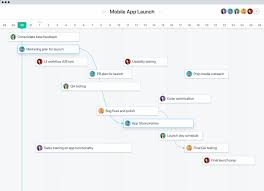Maximising Efficiency: The Impact of Project Planning Software on Organisational Success
The Power of Project Planning Software
Project planning software has revolutionised the way businesses and individuals manage their projects. With its advanced features and capabilities, project planning software offers a comprehensive solution for organising, tracking, and executing projects of all sizes.
Benefits of Project Planning Software:
- Efficiency: Project planning software streamlines the project management process, allowing teams to collaborate effectively and meet deadlines with greater efficiency.
- Resource Allocation: Easily allocate resources, assign tasks, and track progress in real-time, ensuring optimal use of time and manpower.
- Communication: Facilitate seamless communication among team members through built-in messaging systems and collaboration tools.
- Visualization: Visualise project timelines, dependencies, and milestones through interactive Gantt charts and other visualisation tools.
- Flexibility: Adapt to changing project requirements with ease by adjusting schedules, priorities, and resource assignments on the fly.
Popular Project Planning Software Tools:
There are several project planning software tools available in the market that cater to different needs and preferences. Some popular options include:
- Trello: Known for its user-friendly interface and Kanban-style boards, Trello is ideal for agile project management.
- Asana: Asana offers a comprehensive set of features for task management, team collaboration, and project tracking.
- Jira: Widely used in software development projects, Jira provides robust issue tracking and project management capabilities.
- Microsoft Project: A classic choice for traditional project management, Microsoft Project offers powerful scheduling and resource management tools.
In Conclusion
In today’s fast-paced business environment, effective project planning is crucial for success. Project planning software empowers teams to stay organised, communicate efficiently, and deliver projects on time and within budget. By leveraging the power of project planning software tools, businesses can achieve greater productivity, collaboration, and success in their projects.
Essential Insights into Project Planning Software: Ease, Popularity, Steps, and Top Tools
- What is the easiest project management software?
- What is the most popular project management tool?
- What are the 7 steps of project planning?
- Does Office 365 have a project planner?
- Which software is best for project planning?
- Is MS project a planning software?
What is the easiest project management software?
When it comes to project management software, one frequently asked question is, “What is the easiest project management software?” Many users seek a solution that is intuitive, user-friendly, and requires minimal training to get started. While ease of use can be subjective and dependent on individual preferences, some popular project management tools like Trello, Asana, and Monday.com are often recommended for their simple interfaces, drag-and-drop functionality, and clear visualisation of tasks. These platforms offer a straightforward approach to project planning and tracking, making them accessible to users with varying levels of experience in project management.
What is the most popular project management tool?
When it comes to project management tools, one of the most frequently asked questions is, “What is the most popular project management tool?” While popularity can vary based on specific needs and preferences, there are several widely acclaimed project management tools that stand out in the industry. Tools such as Trello, Asana, Jira, and Microsoft Project are among the most popular choices for managing projects efficiently and effectively. Each of these tools offers unique features and functionalities to cater to different project requirements, making them highly sought after by teams and individuals seeking reliable project planning solutions.
What are the 7 steps of project planning?
Project planning is a crucial phase in the project management process, and understanding the key steps involved can greatly enhance project success. The 7 steps of project planning typically include defining project scope, creating a work breakdown structure, identifying tasks and dependencies, estimating resources and timelines, developing a schedule, assigning responsibilities, and establishing a communication plan. By following these structured steps, project managers can effectively outline the project’s objectives, allocate resources efficiently, and ensure clear communication among team members throughout the project lifecycle.
Does Office 365 have a project planner?
Office 365 offers a powerful project management tool called Microsoft Planner, which is designed to help users create plans, organise tasks, assign responsibilities, and track progress in a collaborative environment. With Microsoft Planner, users can easily visualise project timelines, set priorities, and communicate with team members seamlessly. This intuitive tool integrates seamlessly with other Office 365 applications, making it a convenient choice for teams already using the Office suite. Whether you are managing a small team project or a large-scale initiative, Microsoft Planner within Office 365 provides the essential features needed for effective project planning and execution.
Which software is best for project planning?
When it comes to selecting the best software for project planning, the answer largely depends on the specific needs and preferences of the user or organisation. There is a wide range of project planning software available in the market, each offering unique features and capabilities tailored to different types of projects and workflows. Popular choices such as Trello, Asana, Jira, and Microsoft Project are often recommended for their user-friendly interfaces, robust tools for task management and collaboration, as well as advanced features for scheduling and resource allocation. Ultimately, the best software for project planning is one that aligns closely with the requirements and goals of the project at hand, ensuring seamless execution and successful delivery.
Is MS project a planning software?
Yes, Microsoft Project (MS Project) is indeed a project planning software widely used by professionals and organisations for managing projects of various complexities. MS Project offers a range of features such as task scheduling, resource management, budgeting, and timeline tracking, making it a comprehensive tool for project planning and execution. With its intuitive interface and robust capabilities, MS Project enables users to create detailed project plans, allocate resources efficiently, monitor progress effectively, and generate insightful reports to keep projects on track. Overall, Microsoft Project is a powerful planning software that plays a key role in facilitating successful project management processes.



